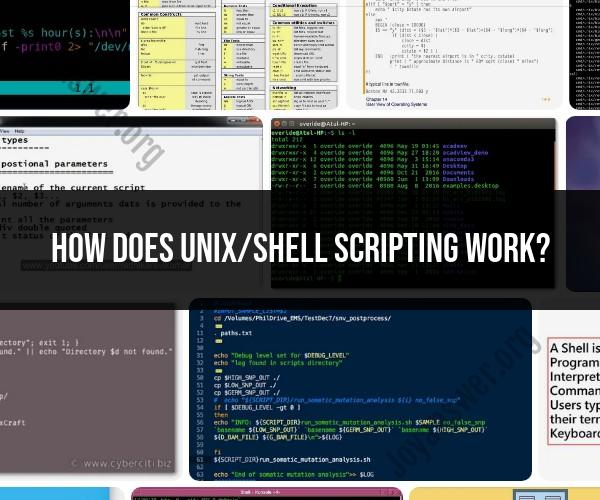How does Unix/shell scripting work?
Unix and shell scripting involve writing and running scripts in a Unix-like operating system, where the "shell" serves as the command-line interface for interacting with the system. Here's an overview of how Unix and shell scripting work:
Understanding the Shell:
- The shell is a command-line interface that allows users to interact with the Unix/Linux operating system by typing commands. Common Unix shells include Bash (Bourne-Again Shell), sh (Bourne Shell), csh (C Shell), and more. Bash is one of the most widely used and is the focus of this explanation.
Writing Shell Scripts:
- A shell script is a plain text file that contains a series of commands that are executed in sequence when the script is run. Shell scripts typically have a ".sh" file extension.
- To create a shell script, you use a text editor (e.g., vi, nano, gedit) to write the script and save it with the ".sh" extension. You also need to make the script executable using the
chmodcommand.
Shebang Line:
- At the beginning of a shell script, you include a "shebang" line that specifies the path to the shell interpreter that should be used to run the script. For Bash, the shebang line is usually
#!/bin/bash.
- At the beginning of a shell script, you include a "shebang" line that specifies the path to the shell interpreter that should be used to run the script. For Bash, the shebang line is usually
Executing Shell Scripts:
- To run a shell script, you use the
./notation followed by the script's filename. For example, if your script is named "myscript.sh," you would run it with./myscript.sh. - You can also execute scripts without the
./notation by adding the script's directory to the system's PATH variable, allowing you to run it from any location.
- To run a shell script, you use the
Writing Commands:
- In a shell script, you can include various Unix commands, such as file manipulation, text processing, system administration, and more.
- You can use variables to store and manipulate data within the script.
- Conditional statements (if, elif, else) and loops (for, while) are used for control flow and decision-making within the script.
Input and Output:
- Shell scripts can take input from users, command-line arguments, or files.
- Output can be displayed in the terminal, redirected to files, or piped into other commands.
Error Handling:
- Shell scripts can include error handling mechanisms to detect and respond to errors or unexpected conditions.
Comments:
- Comments are used to add explanations and documentation to the script. They are preceded by the "#" symbol.
Functions:
- Shell scripts can define functions to encapsulate reusable blocks of code.
Debugging and Testing:
- Debugging tools and techniques are available to identify and fix issues in shell scripts.
- Testing scripts in different scenarios helps ensure they work as intended.
Script Execution Permissions:
- Before running a shell script, ensure that it has execution permission. You can use the
chmod +x scriptname.shcommand to grant execute permission.
- Before running a shell script, ensure that it has execution permission. You can use the
In summary, Unix and shell scripting involve creating text-based scripts that automate tasks and interact with the Unix/Linux operating system. These scripts are powerful tools for system administration, automation, and task simplification in a Unix-like environment. They are essential for managing and customizing Unix-based systems efficiently.












